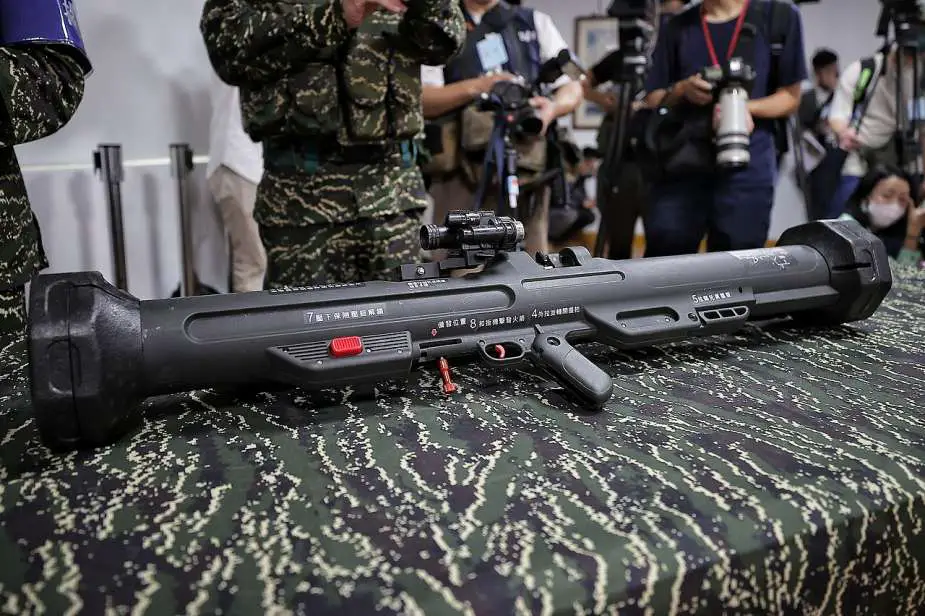According to Taiwan News on November 4, 2023, Taiwan's Ministry of National Defense (MND) has taken a significant step to enhance its military readiness by ordering a total of 10,962 Kestrel anti-tank missiles. This acquisition, valued at NT$109,620,000 (approximately $3,402,393), is part of the broader preparations for the extension of compulsory military service from four months to a full year, set to commence on January 1, 2024.
Follow Army Recognition on Google News at this link

The Kestrel is able to fire High Explosive Anti-Tank (HEAT) rounds against armored vehicles and High Explosive Squash Head (HESH) rounds against hard structures (Picture source: Wikimedia)
The Taiwanese Army had previously purchased 5,000 Kestrel anti-tank missile launchers in September 2022 to equip conscripts for their extended service. This initial order, valued at the time at NT$400 million (US$12.63 million), is now followed by an additional procurement of 5,962 missile sets, expected to be delivered by the end of November 2025. According to Liberty Times Net, the actual procurement started in August 2023.
The objective of these acquisitions is to ensure that Taiwanese soldiers and conscripts serving in anti-tank or relevant units gain practical experience in operating weapons like the Kestrel in response to potential military threats from the People's Republic of China. These domestically-produced missiles are designed and manufactured in Taiwan by the National Chung-Shan Institute of Science and Technology (NCSIST), with a cost per missile significantly reduced to NT$100,000, approximately equivalent to US$3,100.
The adoption of the Kestrel anti-tank missile system extends beyond conscript training. Multiple military units in Taiwan, including the Coast Guard Administration, Marine Corps, military police, and the Army, have already integrated the Kestrel into their arsenal. Notably, the military police have reportedly engaged in exercises using the Kestrel while riding motorbikes near the Presidential Office Building, simulating scenarios related to the defense of the president against potential threats, including those posed by China.
The Kestrel, developed by Taiwan's National Chung-Shan Institute of Science and Technology (NCSIST), is a single-shot, shoulder-launched anti-tank missile launcher capable of firing two different types of projectiles: High Explosive Anti-Tank (HEAT) rounds against armored vehicles and High Explosive Squash Head (HESH) rounds against structures. The Kestrel's projectile also has the ability to penetrate a 30 cm thick brick wall effectively, further enhancing its operational utility.
The Kestrel has a caliber of 67 mm, a length of 1,100 mm, and an estimated weight of 5 kg. The Kestrel is equipped with a foldable telescopic sight that can be easily deployed when needed, offering enhanced accuracy for operators and night vision technology, which facilitates effective targeting at a maximum range of 400 m. Moreover, the weapon is designed to accept various optical attachments, enabling customization to meet specific operational requirements. The primary munition of the Kestrel is the HEAT round, capable of penetrating up to 400 mm of rolled homogeneous armor equivalent, making it effective against a wide range of armored vehicles.
The Kestrel's inclusion of a HESH round sets it apart from modern anti-tank weapons. HESH rounds are known for their ability to create shockwaves and inflict substantial structural damage upon impact, damaging or destroying internal components of the target. This versatility allows the Kestrel to be effective not only against armored vehicles but also against structures and light armor, making it a valuable asset in urban and positional warfare, where precise and effective targeting is essential.
The Kestrel, which was officially unveiled in 2013 and became operational in 2015, was developed with Taiwan's specific military requirements and challenging terrain in mind. It is the only country known to operate the Kestrel rocket launcher, and it remains uncertain whether it has been offered for export to other nations.
The Kestrel's reliability and durability are reinforced by its adherence to stringent military testing standards, meeting the requirements of U.S. military MIL-STD-810G, a set of standards that assess the durability of equipment in various environmental conditions.
These tests include a Saltwater Resistance Test, where the weapon is submerged in a 5% saltwater solution at a depth of 90 cm for 30 minutes to evaluate its resistance to saltwater, vital for operations in coastal or maritime environments. During the Mud Resistance Test, the Kestrel is subjected to 10% concentrated mud at a depth of 30 cm for 30 minutes, assessing its ability to function effectively in muddy conditions that may be encountered in diverse operational environments. Finally, the Sand Resistance Test includes a 30-minute burial in the sand at a depth of 30 cm, ensuring its reliability in sandy conditions, common in arid or desert environments.
















